Attached files
| file | filename |
|---|---|
| 8-K - FORM 8-K - Ameris Bancorp | d387602d8k.htm |
 Second Quarter
2012 Investor Presentation
Exhibit 99.1 |
 Cautionary Statements
Cautionary Statements
2
This presentation contains certain performance measures determined by methods other than in
accordance with accounting principles generally accepted in the United States of
America (“GAAP”). Management of Ameris Bancorp (the “Company”) uses these non-GAAP
measures in its analysis of the Company’s performance. These measures are useful when
evaluating the underlying performance and efficiency of the Company’s operations
and balance sheet. The Company’s management believes that these non-GAAP measures provide a
greater understanding of ongoing operations, enhance comparability of results with prior
periods and demonstrate the effects of significant gains and charges in the current
period. The Company’s management believes that investors may use these non-GAAP financial measures to
evaluate the Company’s financial performance without the impact of unusual items that
may obscure trends in the Company’s underlying performance. These disclosures
should not be viewed as a substitute for financial measures determined in accordance with GAAP, nor are
they necessarily comparable to non-GAAP performance measures that may be presented by
other companies. Tangible common equity and Tier 1 capital ratios are non-GAAP
measures. The Company calculates the Tier 1 capital using current call report instructions. The Company’s
management uses these measures to assess the quality of capital and believes that investors
may find them useful in their evaluation of the Company. These capital measures may,
or may not be necessarily comparable to similar capital measures that may be presented by other
companies.
This presentation may contain statements that constitute “forward-looking
statements” within the meaning of Section 27A of the Securities Act of 1933, as
amended, and Section 21E of the Securities Exchange Act of 1934, as amended. The words “believe”, “estimate”, “expect”,
“intend”, “anticipate” and similar expressions and variations thereof
identify certain of such forward-looking statements, which speak only as of the
dates which they were made. The Company undertakes no obligation to publicly update or revise any forward-looking statements,
whether as a result of new information, future events or otherwise. Readers are cautioned
that any such forward-looking statements are not guarantees of future performance
and involve risks and uncertainties and that actual results may differ materially from those indicated in the
forward-looking statements as a result of various factors. Readers are cautioned not to
place undue reliance on these forward-looking statements and are referred to the
Company’s periodic filings with the Securities and Exchange Commission for a summary of certain factors
that may impact the Company’s results of operations and financial condition. |
 Corporate
Profile Corporate Profile
•
Headquartered in Moultrie, Georgia
•
Founded in 1971 as American Banking Company
•
Historically grown through acquisitions of smaller
banks in areas close to existing operations
•
Recent growth through de novo expansion
strategy and 10 FDIC-assisted transactions
•
Four state footprint with 67 offices
•
Approximately 830 FTEs managing 200,000 core
customer accounts
•
Assets –
$2.9 billion
Loans –
$2.0 billion
Deposits –
$2.6 billion
3 |
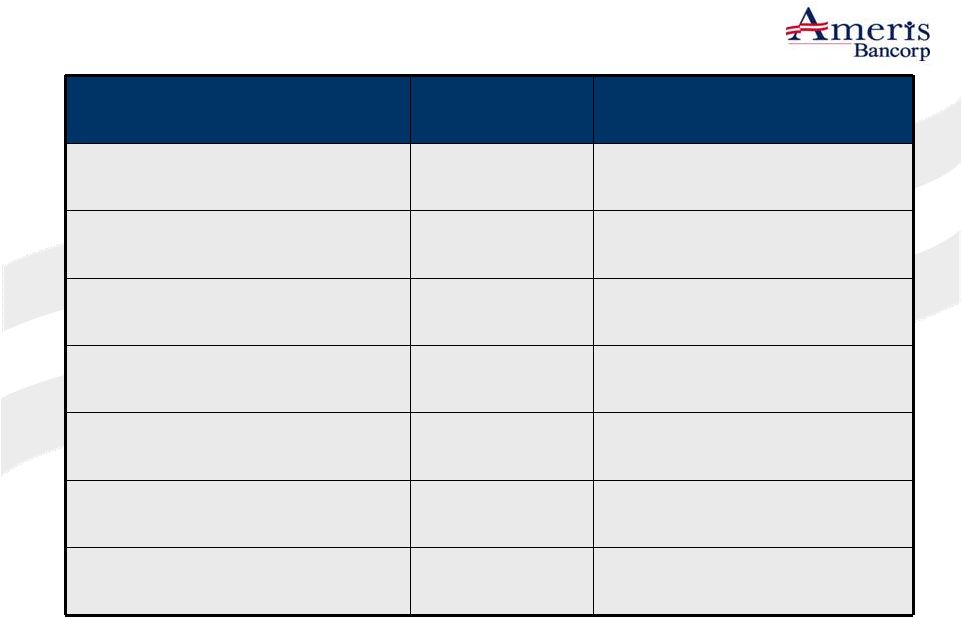 Experienced
Management Team Experienced Management Team
4
NAME / POSITION
EXPERIENCE
(Banking / Ameris)
PREVIOUS
EXPERIENCE
Edwin W. Hortman Jr.
Chief Executive Officer
32/14
Colony Bankcorp, Inc.
Andrew B. Cheney
EVP & Chief Operating Officer
36/3
Barnett Bank, Mercantile Bank
Dennis J. Zember Jr.
EVP & Chief Financial Officer
19/7
Flag Financial Corporation
Jon S. Edwards
EVP & Chief Credit Officer
28/13
NationsBank, Federal Reserve
Stephen A. Melton
EVP, Chief Risk Officer
32/2
Columbus Bank & Trust (lead bank SNV)
Cindi H. Lewis
EVP, Chief Administrative Officer
36/36
Officer at Ameris Bank since 1987
T. Stan Limerick
EVP, Chief Information Officer
7/1
Whitney National Bank
Management and Board Ownership of Approximately 7% |
 Current
Focus Current Focus
Position Ameris Bank as a Consolidator in our 4 Southeastern States
•
FDIC
Assisted
acquisitions
–
Slowing
pipeline
of
opportunities
but
our
markets
still
have
majority
of
potential
deals.
Interest
in
both
Strategic
(builds
market
share)
and
Financial
(builds excess TCE and T1 capital).
•
Traditional
M&A
–
Early
stages
of
a
growing
pipeline
of
opportunities
in
our
footprint
on
larger, thinly capitalized institutions
Realize the positive impacts of our Earnings Strategies
•
Build momentum on growing earning assets and additional revenue opportunities
•
Build unique non-interest lines of businesses to drive non-interest income to top
quartile of our peer group
•
Gain operating leverage from continued consolidation. Significantly reduce
non-provision credit
related
costs
such
that
strong
PTPP
earnings
drive
higher
EPS.
Continue Improving Credit Quality
•
Continue to manage strategies that restore historic quality to our Balance Sheet
•
Reduce credit-related operating expenses incrementally throughout 2012
5 |
 Second Quarter
Update Second Quarter Update
6
(1)
Excludes covered assets, where applicable
dollars in millions, except per share data
Q2 '11
Q3 '11
Q4 '11
Q1 '12
Q2 '12
Change
BALANCE SHEET
Assets
$2,857
$3,010
$2,994
$3,043
$2,920
2.21%
Loans, net
1,812
1,929
1,868
1,949
1,941
7.12
Tang Common Equity / Assets
7.78
%
7.96%
7.96%
7.95%
8.41%
8.10
Tangible Book Value
$9.34
$10.08
$10.06
$10.15
$10.29
10.17
PERFORMANCE
Pre-tax, pre-credit earnings
$13,491
$15,433
$15,030
$13,634
$14,700
8.96%
as a percentage of average
assets
1.89%
2.05%
2.01%
1.79%
2.01%
Revenue (ex acquisition gains)
$34,727
$34,880
$35,259
$34,954
$37,756
8.72
as a percentage of average
assets
4.86%
4.64%
4.71%
4.59%
5.17%
OPEX (ex credit costs)
$18,720
$20,501
$20,926
$21,507
$23,200
23.93
as a percentage of average
assets
2.62%
2.72%
2.80%
2.83%
3.18%
Diluted earnings per share
0.06
0.66
0.01
0.19
0.07
16.67
Net interest margin (TE)
4.21 %
4.44 %
5.21 %
4.48 %
4.66 %
10.69
Efficiency ratio (ex credit costs)
53.91%
58.78%
59.35%
61.53%
61.45%
13.99
CREDIT QUALITY
(1)
NPAs / Assets
4.27
%
3.77%
4.05%
3.03%
2.89%
(32.32)%
Classified Assets / Capital
49.27
41.78
43.93
35.07
32.05
(34.95)
Reserves / Loans
2.54
2.57
2.64
2.17
1.92
(24.41)
Reserves / NPLs
57.02
59.66
49.64
54.90
58.98
3.44 |
 Earnings Growth –
Expansion/Remix of Earning Assets
Short-term plan to convert low yielding assets into traditional earning asset mix
Pickup in net interest income from the strategy is approximately
$26.1 million
7
Balance
Type
84,440
Legacy NPAs
83,467
Covered OREO
203,801
FDIC receivable
151,225
Covered NPLs
111,251
S/T assets
634,184
Total Low Yielding Assets
Balance
Type
475,638
Loans
(75% weighting, 5.00% yields)
126,836
Investments
(20% weight, 2.00% yields)
31,710
S/T assets
(5% weighting, 0.25% yields)
634,184
Traditional E/A mix
•
Majority of the conversion of low yielding assets
expected inside of 2 years
•
Cash flows here do not factor in “growth”.
Management believes growth is possible and costs of
new deposits in 2Q 2012 was approximately 0.40%.
•
Reshuffling asset mix is 100% incremental to ROA
•
After tax pickup of $0.71 per share and 57bps improvement
in ROA
•
Loan generation engine in place, focused on lending niches,
larger relationships in growth markets, existing customers
•
Some loan growth may come from additional FDIC
transactions where assets have higher yields than calculated
here |
 Earnings Growth –
Non-interest Income
Significant
growth
in
mortgage
revenue
–
currently
all
from
retail
activities
•
Still hiring highly experienced, high volume teams
•
Current retail production is $20mm per month, potential
and platform to double in 12-18 months
Started wholesale activities in 2Q 2012
•
Hiring experienced relationship managers from large
wholesale players
•
Larger volume opportunity in wholesale relative to retail
activities
8
Serious about building strength and diversification in non-
interest income sources
•
Moving away from deposit charges
•
Researching unique lines of business
•
Momentum in our numbers coming from mortgage
revenue. We believe we can duplicate that strategy with
other LOBs by hiring expertise.
Peer group comparison are banks greater than $3 billion.
•
BOLI transaction in the 3Q will increase annual revenue by
$2.6 million and NII/Assets by 0.07% |
 Earnings Growth –
Continued growth in Revenue
Revenue growth through this cycle with
opportunistic strategies:
•
27.4% -
CGR for mortgage related revenue
•
23.6% -
CGR for debit interchange fees
•
7.8% -
CGR for analysis and overdraft fees
•
2011 revenue gains boosted by improved net interest margins from
deployment of short-term assets
•
2012-2015 strategy demands:
•
Diversification of revenue with more emphasis on highly profitable
non-interest income LOB’s that enhance ROA and reduce burden on
capital leverage
•
Protect our advantage from strong net interest margins with emphasis on
creating a highly favorable funding mix
9
•
15.0% compounded annual growth rate in total
revenue over the last three years
•
Revenue has grown twice as fast as earning assets
•
Significant amount of assets that will be deployed
over the next 3 years that will significantly boost
revenue and earnings |
 Earnings Growth –
Operating Expense Leverage
10
5 Facts that Point To Significant Leverage in Operating Expense
SAD department fully staffed
•
$5.2 million in annualized cost will trend down over the next couple years as covered and
classified assets decrease Corporate functions can accommodate growth with very little
incremental cost •
Incorporated 10 acquisitions and $1.7 billion in assets in less than 30 months with only 16
additions in staff (excluding SAD functions)
•
Headed by business experts with significant experience. Understand the efficiency
element of M&A. FDIC Insurance is going to decrease substantially
•
$4.1 million reduction in FDIC insurance starting in January 2013 when the prepaid assessment
is fully amortized M&A opportunities exist where primary catalyst for the deal is
operating leverage •
Our M&A strategy is building in existing markets where we can leverage current management
and facilities •
Our core processor contract allows for 50% reduction in processing costs
•
Believe we can integrate targets with less than 2.00% incremental opex/assets
Non-provision credit costs are moderating quickly
•
$3.4 million in 2Q 2012 vs. $12.7 million in 1Q 2012 and $24.7 million in FY 2011.
Expect moderation in these costs in 2H 2012 and into 2013 as credit quality has
improved to peer level |
 Local Deposit
Customers Local Deposit Customers
Drive Profitability & Long Term Franchise Value
Drive Profitability & Long Term Franchise Value
11
•
34.9%
-
Growth rate in Non-interest Bearing Demand during last 12 months
•
64.5%
-
Percentage of deposits in retail oriented transaction style accounts
•
98.0%
-
Percentage
of
Bank’s
total
funding
through
deposits
that
“walks
through
our
front
doors”
(2Q
‘12)
Deposit Composition –
6/30/12
“Zero”
cost deposits –
6/30/12
“Zero”
cost deposits include non-interest bearing checking, NOW accounts and Savings accounts that
cost less than 0.25% and are deemed to have very little sensitivity to changing interest
rates.. |
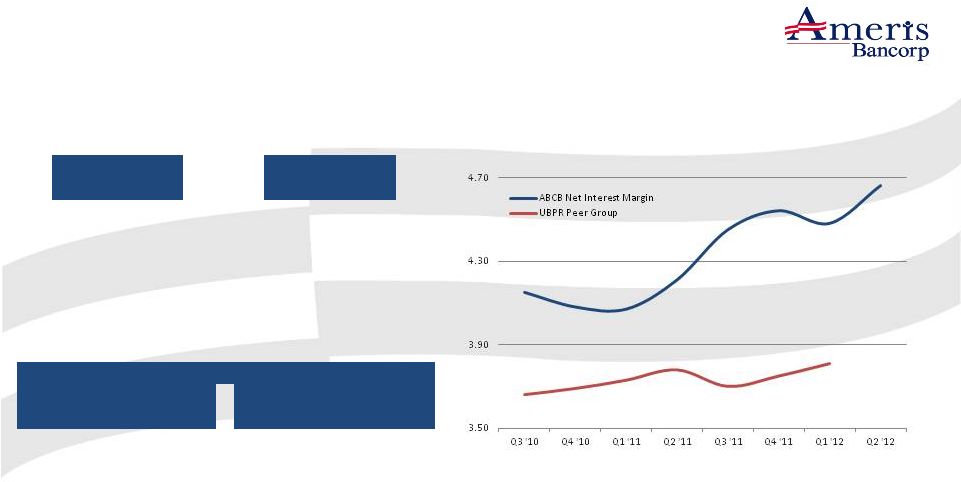 Net Interest
Margin Net Interest Margin
12
(1)
Maturity and Repricing Opportunity are amounts and yields maturing in the designated
quarter (2)
Ameris Bank net interest margin on a fully taxable-equivalent basis, excludes H/C level
TRUPs .
Net Interest Margin
Net Interest Margin
(2)
(2)
(%)
(%)
“Acquisition Yields”
Loans
CDs
Quarter
Yield
Quarter
Yield
Q3 '11
5.62%
Q3 '11
0.96%
Q4 '11
5.38%
Q4 '11
0.67%
Q1 '12
5.48%
Q1 '12
0.65%
Q2 '12
5.45%
Q2 '12
0.54%
Maturity
&
Repricing
Opportunity
(1)
(1)
)
Upcoming Maturities and Expected Renewals:
Quarter
Loans -
Balance
Maturing
Yield
Quarter
CDs -
Balance
Maturing
Cost
Q3 '12
$ 144,165
5.82%
Q3 '12
$ 232,812
1.05%
Q4 '12
$ 123,207
5.98%
Q4 '12
$ 186,914
0.89%
•
Maturing
Balances
and
yields
relative
to
“Acquisition
Yields”
are
still
in
Ameris
Bank’s
favor
•
53.5% -
Increase in new loan volume in Q2 2012 vs. Q3 2011
4.15
4.07
4.45
4.66 |
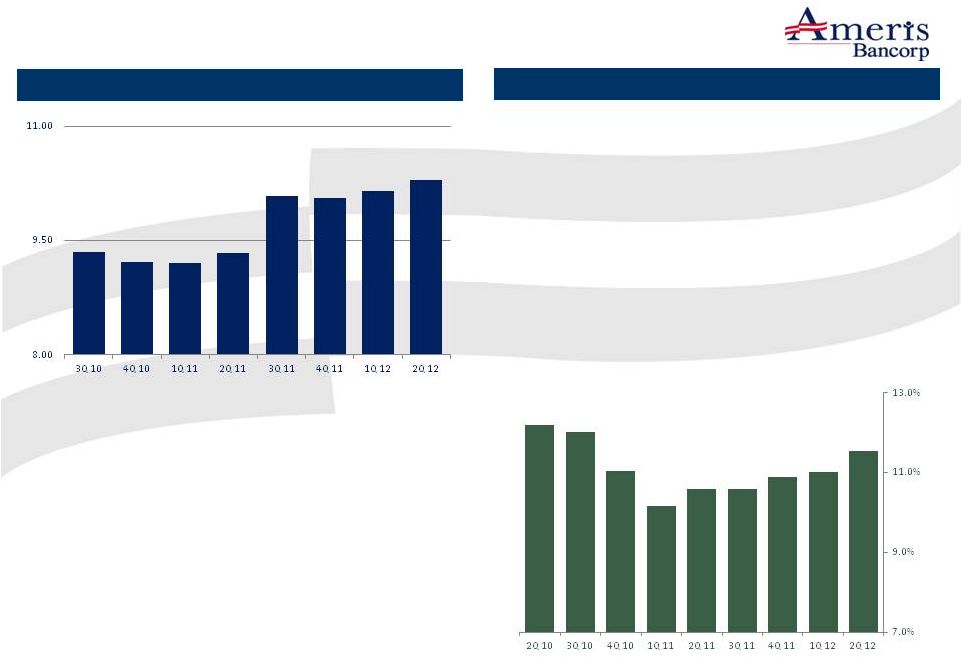 Significant
Capital Strength Significant Capital Strength
Adequate for TARP repayment and further growth
Adequate for TARP repayment and further growth
(1)
Tangible book value per share adjusted for stock dividends
13
Growing Tangible Book Value
Significant Capital left to Leverage
•
9.95% -
Proforma Tier 1 capital assuming
TARP repayment
•
8.40% Proforma TCE / TA assuming TARP
repayment
•
Additional growth of $1.36 billion possible
(leverages T1 Leverage to 8.00%) with no
additional earnings or capital raise
•
10.2% increase in TBV over the past year
•
Successfully earned our way through the
economic cycle with strong core earnings
from our “core/relationship”
oriented
balance sheet
$9.35
$9.22
$9.20
$9.34
$10.08
$10.06
$10.15
$10.29
12.2%
12.0%
11.1%
10.2%
10.6%
10.6%
10.9%
11.0%
11.5%
Tier 1 Leverage Ratio |
 FDIC-Assisted Acquisitions –
FDIC-Assisted Acquisitions –
leading the nation in number of deals
leading the nation in number of deals
14
•
Line of business -
experienced teams managing workout of assets, fair value
experienced teams managing workout of assets, fair value
accounting and data conversions
accounting and data conversions
•
Self-capitalizing -
acquisition gain plus subsequent earnings have capitalized
acquisition gain plus subsequent earnings have capitalized
approximately 5.50% of acquired assets
approximately 5.50% of acquired assets
•
Serious about Cost Savings
–
–
10 of the 25 offices acquired have been closed or are
10 of the 25 offices acquired have been closed or are
scheduled to close before EOY 2012
scheduled to close before EOY 2012
Bank
Acquisition Date
Assets, FV
Deposits, FV
Discount Bid
Deposit Premium
Gain/
(Goodwill)
American United Bank
Oct-09
120,994
100,470
(19,645)
262
12,445
United Security Bank
Nov-09
169,172
141,094
(32,615)
228
26,121
Satilla Community Bank
May-10
84,342
75,530
(14,395)
92
8,208
First Bank of Jacksonville
Oct-10
77,705
71,869
(4,810)
-
2,382
Tifton Banking Company
Nov-10
132,036
132,939
(3,973)
-
(955)
Darby Bank & Trust
Nov-10
598,204
444,100
(45,002)
-
4,211
One Georgia Bank
Jul-11
184,344
160,711
(22,500)
-
6,000
High Trust Bank
Jul-11
183,880
170,967
(33,500)
-
14,308
Central Bank of Georgia
Feb-12
261,289
261,036
(33,900)
-
20,037
Montgomery Bank and Trust
Jul-12
18,117
156,647
-
-
-
1,830,083
1,715,363
(210,340)
582
92,757 |
 Potential
Consolidation Opportunities Potential Consolidation Opportunities
(data for banks in our four state footprint)
(data for banks in our four state footprint)
“Loss-Share”
M&A Opportunities
(2)
(1)
Banks in Ga, Fl, Al and SC with Texas Ratio over 50% but below 100%. Total assets under
$2 billion. Excludes banks with covered assets (2)
Banks in Ga, Fl, Al and SC with Texas Ratio over 100%. Total assets under $2
billion. Excludes banks with covered assets 15
Traditional M&A Opportunities
(1)
“Traditional”
M&A
“Loss-Share”
M&A
•
Majority remaining are smaller banks where consolidation
opportunities would favor Ameris Bank
•
Average assets of approximately $250 million
•
Regulatory pressure to “make something happen”
on capital levels
and problem assets
•
Average Tier 1 leverage (incl h/c debt) of approximately 5.00%
•
20% of all banks under $2 billion in our four states have Tx
ratio between 50% and 100%
•
Some
improvement
in
number
of
“problem”
banks,
but
almost always from deleveraging vs. new capital or earnings
growth
•
Credit marks in purchase transaction are very punitive given
levels of classified assets and limit acquirers ability to
maintain TBV levels in recapitalization
•
These banks are receiving significant pressure from regulatory
agencies to strategically develop sources of capital and a
rapid path to profitability
•
Similar
in
average
assets
to
“loss
share”
M&A
opportunities
•
20%
of all banks under $2 billion in our four states have Tx
ratio over 100% |
 •
Diversified loan portfolio across five regions
–
Inland Georgia –
51%
–
Coastal Georgia –
15%
–
Alabama –
9%
•
In-house lending limit of $7.5 million versus $75 million legal limit
–
4 loans greater than $5 million
•
Loan participations less than 1.00% of total loans
•
Aggressive management of concentrations of credit
•
Top 25 relationships
are only 10.3% of total loans
Loan Portfolio Detail
Loan Portfolio Detail
16
Loan Portfolio Detail –
6/30/12
–
South Carolina –
13%
–
Florida –
12%
Loan Type
Average Loan
Size
Average Rate
Commercial R/E
$ 325,927
5.49 %
C&D
108,310
5.52
Residential
67,919
5.91
C&I
54,415
5.19
Consumer
6,949
6.68
Agriculture
113,720
5.90
Total
$ 77,452
5.66 % |
 Loan
Growth Opportunity •
Leveraging presence in new markets (top five markets
account for 70% of pipeline:
Atlanta, Jacksonville, Columbia, Tallahassee, Charleston
•
Upgrading production positions in key markets
production.
•
Expanding Mortgage Strategy
Jumbo mortgages, wholesale, warehouse LOC
•
Leveraging Agricultural expertise
•
Specialty lines of business that would diversify loan
portfolio
Growth in Loan Pipelines
Lending Strategies
•
Yields on current production exceed 5.40%
•
2/3
rds
of production is with existing
customers
–
higher
rates
(40bps-50bps
from
relationships)
•
Diversified
loan
types
–
not
solely
chasing
CRE or competing with low rates that do not
compensate for term or quality
17
Portfolio Diversification by Type
limited
changes
to
expense
base
but
higher
levels
of
quality
better yields than in CRE due to limited competition |
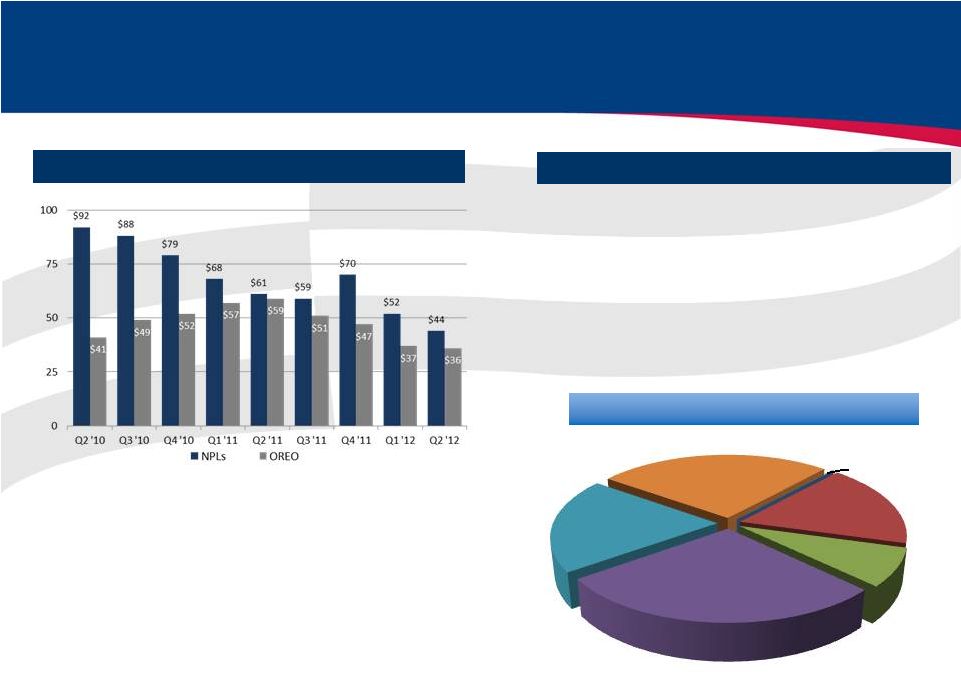 Credit Quality –
Substantial Improvement
Breakdown of OREO by Type
•
Values are appropriate for sale to end users
•
1Q
2012
Disposal
activity
–
More
aggressive
posture resulted in a $31.2 million reduction in
classified assets at 63%, net of reserves
Trends in NPA’s
OREO
•
NPLs down 52% from their peak levels over
2 years ago
18
AGRE Land,
$0.05 , 0%
Subdiv & lots,
$6.30 , 17%
SFR, $2.80 , 8%
CML Land,
$10.00 , 28%
CML Properties,
$7.10 , 20%
RRE Land, $9.60
, 27% |
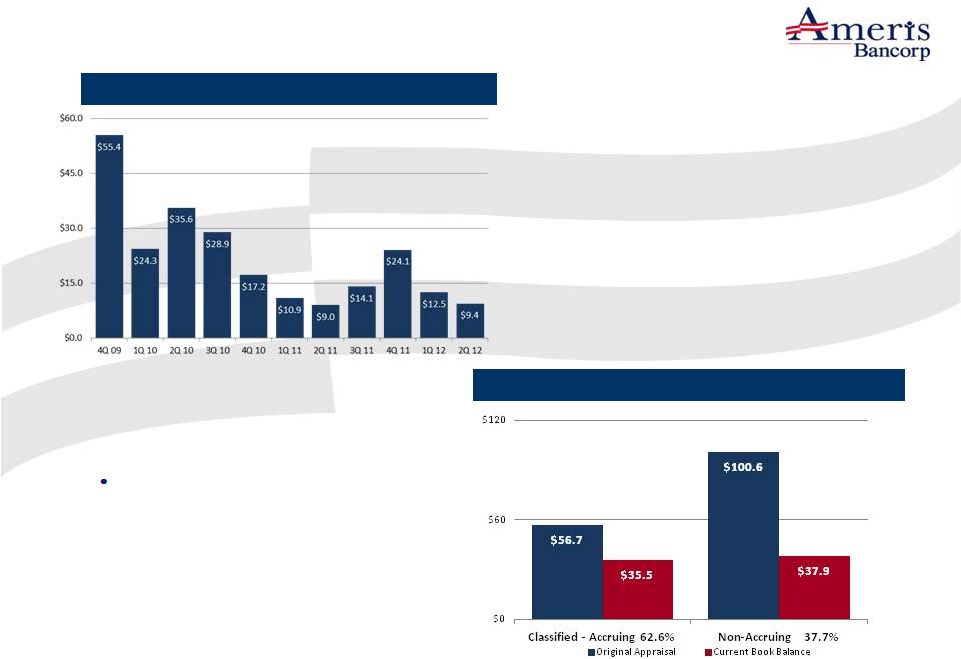 Credit
Cycle Credit Cycle
19
Average
Quarterly
“In-migration”
of
problem
loans:
2010:
$ 26.5mm
•
2011:
$ 14.5mm
•
2012 (1H)
$ 10.9mm
(1) Cumulative losses defined as provision for loan losses plus (gains)/losses on
the sale of OREO (2) Net Book balance of classified loans and
non-accruing loans is net of specific LLRs In-Migration
of
New
Problem
Loans
(1)
Conservative
Carrying
Values
of
Classified
Assets
(2)
•
45%
Decline
–
In-migration
of
new
non-
accrual loans down significantly in 2011 over
2010
•
4 quarter 2011 increase in in-migration was
concentrated in several larger relationships.
All have resolution strategies implemented
•
Management anticipates continued trends of
lower in-migration for 2H 2012 over 2011
levels, although not visually linear
th |
 Second Quarter
2012 Investor Presentation |
